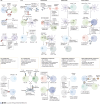Targeting TNF/TNFR superfamilies in immune-mediated inflammatory diseases
- PMID: 39297883
- PMCID: PMC11413425
- DOI: 10.1084/jem.20240806
Targeting TNF/TNFR superfamilies in immune-mediated inflammatory diseases
Abstract
Dysregulated signaling from TNF and TNFR proteins is implicated in several immune-mediated inflammatory diseases (IMIDs). This review centers around seven IMIDs (rheumatoid arthritis, systemic lupus erythematosus, Crohn's disease, ulcerative colitis, psoriasis, atopic dermatitis, and asthma) with substantial unmet medical needs and sheds light on the signaling mechanisms, disease relevance, and evolving drug development activities for five TNF/TNFR signaling axes that garner substantial drug development interest in these focus conditions. The review also explores the current landscape of therapeutics, emphasizing the limitations of the approved biologics, and the opportunities presented by small-molecule inhibitors and combination antagonists of TNF/TNFR signaling.
© 2024 Pfizer Inc.
Conflict of interest statement
Disclosures: P.K. Veerasubramanian, T.A. Wynn, J. Quan, and F.J. Karlsson are employees of Pfizer and may hold stock and/or stock options with Pfizer. No other disclosures were reported.
Figures

References
-
- Alpine Immune Sciences . 2024. Alpine Immune Sciences Shares Updated Clinical Data from Povetacicept in IgA Nephropathy. Alpine Immune Sciences Inc. (Press release). https://ir.alpineimmunesciences.com/news/news-details/2024/Alpine-Immune... (accessed June 20, 2024).
-
- Andrews, J.S., Berger A.E., and Ware C.F.. 1990. Characterization of the receptor for tumor necrosis factor (TNF) and lymphotoxin (LT) on human T lymphocytes. TNF and LT differ in their receptor binding properties and the induction of MHC class I proteins on a human CD4+ T cell hybridoma. J. Immunol. 144:2582–2591. - PubMed
Publication types
MeSH terms
Substances
LinkOut - more resources
Full Text Sources

